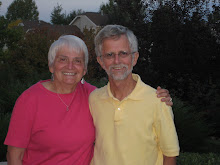



Then off to another wonderful breakfast at the Inn.
Then it was Jean's turn with the camera as Williamsburg was coming to life.


We ran into these surveyors on our way to the palace. We got an explanation of how they used their instruments to measure property lines.

One of the merchants heading to her shop.

Then on to the Palace Garden and a presentation called "So Far from Scioto, a Revolutionary Story". This program is part of Colonial Williamsburg Foundation's American Indian Initiative that develops, implements and supports programming, activities and projects through partnerships with American Indian communitives, Native-focused institutions, scholars and individuals who support cultural relevancy, accuracy and period appropriateness for 18th Century Williamsburg.
In the fall of 1774, Lord Dunmore, the last British royal governor in Virginia, waged war against the Shawnee along the upper Ohio River. As part of a peace agreement at the end of the conflict, a group of young Shawnee chieftains was sent to Williamsburg as part of a peace bond--a security that the Indians would cease raiding American settlements along the Ohio.
Lord Dunmore entertained the Shawnee emissaries during their stay in Williamsburg, introduced them to high society as special guests at Palace balls and traveled them through the Tidewater aboard a three-masted frigate. Evidence suggests that the delegation enjoyed the hospitality of formal dinners, carriage rides and possibly stayed with Dunmore at the Governor's Palace.
In Feb. 1775, trouble appeared to be brewing again in the Ohio between frontier whites and indigenous peoples. Equally, the Virginians were becoming increasingly restless with the colonial government and tensions were mounting in the face of growing conflict between the British Crown and Virginia's Patriots. The play takes place on June 7, 1775 when the Shawnee emissaries are trying to decide whether to stay or escape and return to Ohio. It was very well done and a great addition to the history of the period.



Following the play, we headed to Bassett Hall, the Williamsburg home of Abby and John D. Rockefeller, Jr. In the early 1900's, The Reverend W.A.R. Goodwin, rector of Bruton Parish, was inspired by the survival of so many 18th century buildings and by the role Williamsburg played during the American Revolution. He dreamed of restoring the city to its 18th century glory. He was able to communicate this vision to John D. Rockefeller, Jr in 1926 and Rockefeller gave the project his enthusiastic support for more than thirty years. He contributed the necessary funds to accomplish the restoration and established an endowment to provide for its educational programs. He and his wife would come down for two weeks in the spring and two in the fall and stay at Bassett House while he oversaw the restoration. The house was bequeathed to the Foundation in 1979 along with its furnishings and a 585 acre tract of rolling woodland.

After our tour we packed up and headed home. We stopped at the Petersburg National Battlefield, a Civil War battlefield, on the way home.
Petersburg National Battlefield
This battlefield commemorates the 9 1/2 month seige upon Petersburg from June 1864 to April 1865 by Grants Union Forces. For history of this Battlefield visit www.nps.gov/pete/historyculture/index.htm


 One of the fascinating battles of this area was the Crater battle. For months, coal miners from Penn who were in Gen. Grant's Union Army worked on digging a tunnel that ended under a part of Gen. Lee's line known as Elliott's Salient. On July 30, 1864, Union troops exploded the mine under the Confederate battery attempting to create a breakthrough into Petersburg. It created a huge crater but the follow-up attack by the Union troops was a disaster. The displays in the Museum about this mine were terrific.
One of the fascinating battles of this area was the Crater battle. For months, coal miners from Penn who were in Gen. Grant's Union Army worked on digging a tunnel that ended under a part of Gen. Lee's line known as Elliott's Salient. On July 30, 1864, Union troops exploded the mine under the Confederate battery attempting to create a breakthrough into Petersburg. It created a huge crater but the follow-up attack by the Union troops was a disaster. The displays in the Museum about this mine were terrific.After wandering the area for several hours, we headed home. What a great mini-vacation. We went from the first settlement in America, through the buildup to the Revolutionary War to the Civil War in three short days. Thanks to Gretchen and Jill, Dave, Colin and Ryan for a great 65th Birthday present!!




























